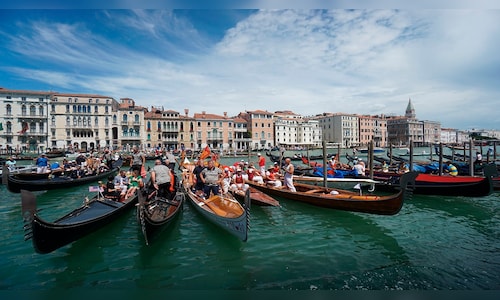Last year, 747 million international travelers arrived on the continent, significantly surpassing any other region globally, according to the UN’s World Tourism Barometer. Over 70% of these visitors flocked to Southern and Western Europe.
As this surge in travelers puts pressure on housing, water resources, and the most Instagram-friendly locales, protests and initiatives aimed at combating overtourism have become increasingly common.
Here’s a glimpse into the situation in some of Europe’s most frequented destinations:
Contributing to these record numbers are budget flights, social media influence, the convenience of travel planning through artificial intelligence, and what UN tourism officials describe as a solid economic outlook for many affluent nations, despite some geopolitical uncertainties.
Tourists from countries like the US, Japan, China, and the UK account for the highest number of international trips, particularly to sought-after spots like Barcelona in Spain and Venice in Italy. They flock to these locations seasonally, creating spikes in demand for housing and basic resources like water.
Also read | Fed up with overtourism, protesters take to streets in southern Europe
Although there is widespread concern about the crowds, some tourism officials believe that effective management can alleviate the issue through improved infrastructure.
Italy’s Tourism Minister Daniela Santanchè stated that the flow of tourists at heavily visited sites such as Florence’s Uffizi Galleries, home to renowned artworks, could be better organized using AI, allowing tourists to purchase tickets months in advance to mitigate congestion.
She dismissed the notion that Italy faces an oversupply of tourists, noting that most visits are concentrated within only 4% of the country’s area.
Also read | Overtourism in Spain: Thousands of residents take to streets again as rents continue to rise
“It’s a phenomenon that can absolutely be managed,” Santanchè told The Associated Press in an interview last Friday. “Tourism should be viewed as an opportunity, not a threat — even for local communities. That’s why we’re focused on organizing flows.”
Countries around the Mediterranean lead the way. France, which hosted the Olympics, gained 100 million international visitors last year, while Spain was close behind with nearly 94 million — almost double its own population.
Over the past two years, Spain has seen protests erupt across its cities. In Barcelona, the water gun has become emblematic of the city’s anti-tourism movement, as protestors spray unsuspecting tourists with water while brandishing signs that read: “One more tourist, one less resident!”
The strain on infrastructure has been particularly severe in Spain’s Canary and Balearic Islands, which together have a population of under 5 million yet welcomed over 15 million visitors last year.
Beyond Spain, popular sites in Italy such as Venice, Rome, Capri, and Verona face similar overcrowding challenges. On the famous Amalfi Coast, ride-hailing services like Uber offer private helicopter and boat rides during peak season to help tourists evade the crowds.
Greece experienced nearly four times as many tourists as its resident population last year, grappling with shortages in water, housing, and energy during the summer, particularly on beloved islands like Santorini and Mykonos.
In Spain, activists, scholars, and government representatives argue that overtourism drives up housing costs in central and other desirable locations, largely due to the rise of short-term rentals catering to visitors.
Others lament the transformations of neighborhoods that originally attracted tourists.
In Barcelona and beyond, activists and academics claim that areas popular with visitors have seen local shops replaced by souvenir stalls, global franchises, and trendy eateries.
Some of Greece’s most-visited islands face challenges related to water scarcity as drought affects the Mediterranean region of 10.4 million residents.
Also read | As Italy grapples with overtourism, Florence bans check-in keyboxes
In France, the Louvre, the world’s most-visited museum, recently closed when staff went on strike, citing concerns about the facility crumbling under tourist pressures, leaving thousands of ticket holders stranded in the sweltering sun.
Angelos Varvarousis, an academic and urban planner based in Barcelona and Athens, warns that overtourism may impose a “monoculture” on Europe’s popular destinations.
“It is combined with the gradual loss and displacement of other social and economic activities,” Varvarousis observed.
Spain’s government aims to address what officials deem the country’s greatest governance challenge: its housing crisis.
Last month, Spain’s government ordered Airbnb to remove nearly 66,000 properties claimed to have breached local regulations, while Barcelona unveiled plans to phase out all 10,000 licensed short-term rentals in the city by 2028 to preserve housing for permanent residents.
Similarly, other authorities are implementing regulations on tourist flows, including restrictions on overnight stays or imposing fees for cruise visitors.
Starting July 1 in Greece, a cruise tax will be applied to island visitors, charging 20 euros ($23) for popular destinations like Mykonos and 5 euros ($5.70) for less-frequented islands such as Samos.
The government is also promoting visits to quieter locales.
To tackle water shortages, water tankers from mainland Greece have been deployed to arid islands, and desalination technology is being utilized to convert seawater into drinkable water.



